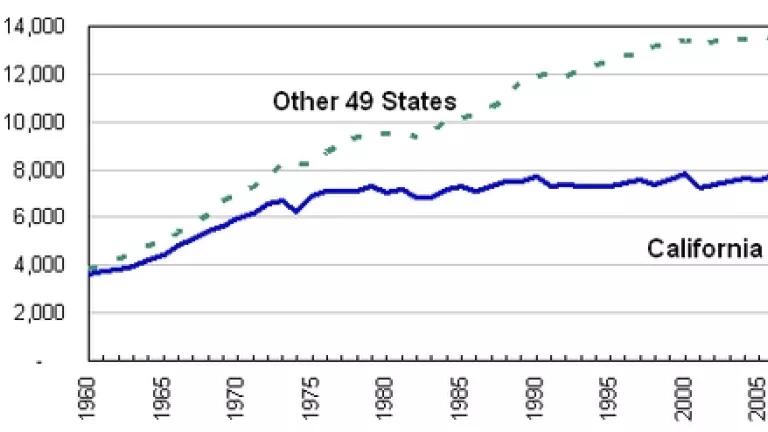
A new paper released by NRDC today describes how California restored its energy efficiency leadership by enacting smart policies over the last decade. These energy efficiency programs provide enormous economic and environmental benefits to the state.
We released the paper at the U.C. Davis Energy Efficiency Center’s Symposium honoring Dr. Arthur Rosenfeld, recently retired member of the California Energy Commission. NRDC’s paper is dedicated to Dr. Rosenfeld, “whose visionary leadership in the field of energy efficiency has inspired new generations to follow in his footsteps.” If energy efficiency could carry a flag, it would look like the aptly named “Rosenfeld Curve:”
Per Capita Electricity Consumption
In the 1970s, California embarked on an uncharted path to pursue energy efficiency, and it has yielded impressive results. The idea that consumers can get the same level of service – light, heat, and other modern day necessities – while using less energy, once a new and untested concept, is now a proven tool to deliver huge benefits for consumers. A short list of benefits from energy efficiency includes: it saves customers money on their utility bills, creates net growth in jobs, helps drive the wheels of innovation, and it cleans the air and helps curb global warming to boot.
Energy efficiency programs help customers lower their energy bills by providing information and rebates on more efficient products. (Find out what programs you can take advantage of by calling your local utility or Flex Your Power.)
In the early 1990s, California became a leader on energy efficiency, only to let its programs fall by the wayside as the state rushed into its now infamous deregulation experiment. In the aftermath of California’s electricity crisis, the state began reassembling the policies necessary to support energy efficiency. Smart policies enacted over the last decade have restored the state’s leadership, and the energy efficiency programs’ achievements are remarkable:
- California’s programs increased net benefits (that is, the benefits after deducting all the costs) to consumers nearly five-fold over the last decade, totaling nearly $5 billion.
- California increased its energy savings almost six-fold in the last decade, reaching more than 3,400 GWh of annual savings in 2008. (Translation: in 2008, the state saved the same amount of energy it takes to power all the households in San Francisco and San Mateo counties combined.)
- The efficiency costs less than half of what the baseload power that it replaces costs, coming in at 3 c/kWh instead of 8 c/kWh.
- California's economic productivity for every kWh of electricity consumed has improved over 50% in real dollars since 1980. (In contrast, the rest of the US has improved only 15%.)
- In 2008, the pollution savings from efficiency programs (which have accumulated since the state first began programs in earnest in the mid-1970s) totaled nearly 1,000 tons of smog-forming nitrogen-oxides and provided global warming pollution savings equivalent to the emissions from approximately 3 million cars.
California has shown once again that it’s faster, cheaper, and cleaner to save energy than to produce it. And the state is far from exhausting the potential savings from efficiency. California regulators recently approved utility efficiency programs for the next three years that are expected to further increase savings and create 15,000 jobs.
Over the past decade, California re-established itself as a leader in energy efficiency, but with Congress poised to enact a nationwide limit on global warming pollution and consumers feeling the pinch of high utility bills, states around the country are now vying to take the lead on energy efficiency. For example, Massachusetts recently set its sights on surpassing California . California, the clean energy race is a competition in which everyone wins. We have pioneered energy efficiency before; we are the architects of innovative policy; and we already know how to harness the jobs and dollars that flow from energy efficiency. There is nothing holding us back now.
